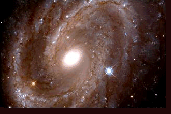
|
Astronomy Briefly brought to you by Duane Dunkerson |
 |
|
|
|
||||||
| Mars:
Uncovering the Secrets of the Red Planet, by Paul Raeburn, foreword and
commentary by Matt Golombek. National Geographic Society, 1998. reviewed by Duane Dunkerson Yogi and Barnacle Bill are names for rocks on Mars. They are on the surface of a planet, which has proved to hold a fascination for the potential for life as we know it. In the book is to be found mention of ancient mythology pertaining to Mars, Percival Lowell is shown at the telescope, and Orson Welles is seen at the microphone. But the text is mostly about two NASA missions to Mars, Viking and Pathfinder. The two already mentioned rocks were named after Pathfinder established itself on Mars. It has been estimated that to fully explore Mars will take centuries. Those two rocks may be long forgotten decades from now. More NASA missions to Mars are planned for 2001,2003,2005, and beyond. Those two rocks and the other named ones in the Pathfinder locale rest on the last of the terrestrial planets. It has seasons, huge dust storms, an atmosphere, sand dunes in abundance, and polar caps. Most now think it once had flowing water, lots of water. Life too? Maybe once. Maybe now. If they are to be found by us, Martians could be microbe-like under the surface. There is no doubt about Yogi and Barnacle Bill. They are there on the surface. They have brethren here on earth. Twelve rocks have visited us. Some of these SNC meteorites were found in France, India, and Brazil. They were blasted from Mars and eventually fell to earth. Of these, the Allan Hills (Antarctica) rock from Mars shows possible life in its innards. It is not instantly recognized as our life but maybe a life. If Yogi and Barnacle Bill could talk, would they know of the cratered face of Mars that Mariner 4 first conclusively showed? Mariner 6 and 7 got closer with better cameras. Ammonia and methane were found near the poles. Then would the rocks prefer to comment on Mariner 9's gigantic volcanoes and vast canyons? Would these two rocks wonder what is the hubbub about life? Presumably these rocks have not been of the living. So what's the big deal about flying cheaper to Mars with the most onboard computer power ever? A non-standard project team put together the Pathfinder mission. A great deal of how the Viking people 21 years before had accomplished their tasks had been forgotten or hard to find. So lookout Yogi and B Bill, here comes Pathfinder, bouncing along the surface in your rocky backyard. Not like Viking or the moon mission, but coming faster on a flatter trajectory. Pathfinder was surrounded by inflated bags and once Pathfinder stopped bouncing along, the bags deflated and Pathfinder folded down and there's Yogi and Bill. They were found to be there because two and one half years went into selecting a site above which Pathfinder would have 55 seconds left to go, latitude to power the solar cells, and with radar not disappearing into dust. If we could get Yogi and Bill back here, they would probably now be worth more than Pathfinder cost. As it is, Pathfinder was cheaper to fly than "Titanic" was to film. For a time, an hour and a half before landing, if it hadn't been for fill bits named Jordan Kaplan in the regular reports Pathfinder sent, Yogi and Bill would be nameless. Valves on Pathfinder weren't operating properly, which version of the craft's software was being used? The Pathfinder team needed to know the correct version to correctly communicate with the spacecraft. The correct one contained Mr. Kaplan's name. Did it say Kaplan? Yes it did. Then Yogi and Bill were to come into existence. The stunning photos make this a book to have. The text intervenes at
times, but it covers the main points well enough. |
Copyright © 2024 by Duane Dunkerson All Rights Reserved |
|||||
|
|
If you wish,
send me email telling me what you think about these articles, headline; etc. Also if you have a questionrelating to astronomical matters, I can answer it or refer you. |
|||||